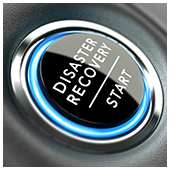 The new year is well upon us, and with it comes getting back down to business and planning for the end of financial year... With the advancements in computing technology, many 2017 business wish lists probably include powerful onsite servers, workstations, and the Internet of Things.
The new year is well upon us, and with it comes getting back down to business and planning for the end of financial year... With the advancements in computing technology, many 2017 business wish lists probably include powerful onsite servers, workstations, and the Internet of Things.
But as tempting as these purchases may be, it’s important that you don’t dismiss an old yet essential IT resolution: disaster recovery.
Contact us below for more information on how we can assist in developing or supporting your disaster recovery plan...
DR isn’t a huge investment
A common misconception about disaster recovery is that it’s a large, bank-breaking investment. Expensive secondary data centers, networks, and server maintenance usually come into mind when a business owner is confronted with the idea of business continuity. And while that may have been true in the past, establishing a strong disaster recovery plan today is as simple -- and as cheap -- as going to a cloud-based disaster recovery provider and paying for the data and services that your business needs. Subscription pricing models are actually incredibly low, meaning you can have minimal downtime while still having enough to invest in new tech.
Onsite backups just won’t cut it
Although you might feel secure with a manual backup server down the hall, it is still susceptible to local disasters and, ultimately, does very little in minimizing company downtime. When disaster recovery solutions are hosted in the cloud or in a virtualized server, restoring critical data and applications only take a few minutes.
Business disasters can be man-made, too
Even if your workplace is nowhere near frequent disaster zones, cyber attacks and negligent employees can leave the same impact on your business as any natural disaster can. Setting a weak password, clicking on a suspicious link, or connecting to unsecured channels is enough to shut down a 5-, 10-, or even 50-year-old business in mere minutes.
Sure, installing adequate network security is a critical strategy against malicious actors, but last year’s barrage of data breaches suggests that having a Plan B is a must. A suitable disaster recovery plan ensures that your data’s integrity is intact and your business can keep going, no matter the malware, worm, or denial-of-service attack.
Downtime will cost you
A business without a DR plan might come out unscathed after a brief power outage, but why risk the potential damages? Either way, downtime will cost your business. First, there’s the general loss of productivity. Every time your employees aren’t connected to the network, money goes down the drain. Then there’s the cost of corrupted company data, damaged hardware, and the inevitable customer backlash. Add all those variables together, and you end up with a business-crippling fee.
So, if you want 2017 to be the best year for your business, make the smart choice and proactively take part in creating your company’s business continuity plan. Your business will be in a better position financially with it than without it.
Contact Us
Keep your business safe in 2017 and recover from any disaster by getting in touch with us today. Contact us below or call us today on 1300 307 907.
Published with permission from TechAdvisory.org




